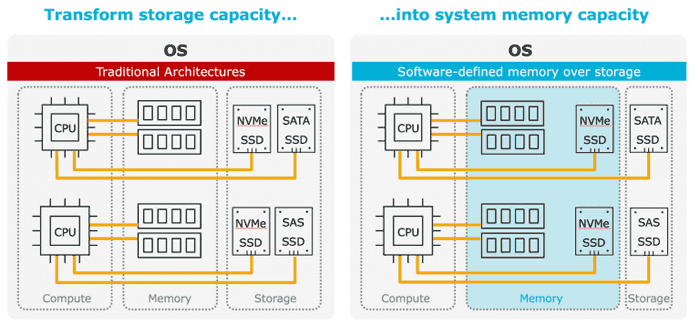At Supercomputing 2018 (SC18), Western Digital (WD) has announced a new product targeting the in-memory computing market segment. WD envisions the product being used for real-time data processing, application caching, large-scale databases, and acceleration for the data-driven economy. It claims that its solution can provide up to 24TiB in a 1U server for use as virtualized memory without significant loss in application performance. Furthermore, in use the new product is transparent, a drop-in PCIe card compatible with most Intel x86 servers, requiring no changes to the existing operating systems or applications “for near-DRAM performance”.

WD’s solution is the Ultrastar DC ME200 Memory Extension Drive. At its heart is an optimised Ultrastar SN200 SSD, which uses planar 15nm MLC (2bits/cell) NAND and WD’s software defined memory over storage tech. Thus, this fast PCIe storage is configured as a virtual memory pool in line with system DRAM, rather than storage.

20+ prefetch, prediction, and optimising algorithms help the Ultrastar DC ME200 Memory Drive work at near DRAM performance levels, according to WD. Users will benefit from significant cost savings over DRAM capacity expansion, and easily bypass DRAM limits set by physical DIMM slots. Some example server application performance figures were shared by The Register, as below:
- Memcached has 85-91 per cent of DRAM performance with a 4-8x memory expansion from the Ultrastar DC ME200 Memory Drive
- Redis has 86-94 per cent DRAM performance with 4x memory expansion
- MySQL has 74-80 per cent DRAM performance with 4-8x memory expansion
- SGEMM has 93 per cent DRAM performance with 8x memory expansion

WD’s Ultrastar DC ME200 Memory Drive presents an obvious rival to Intel’s Optane products. Talking about the competition, Eddie Ramirez, Western Digital director of product management, highlighted that “We offer three times more capacity...” before adding that with Optane SSDs “There's not enough compelling performance gain with Optane to justify the cost difference.”
A possible fly in WD’s ointment will be if its 20+ algorithms have bugs, compatibility issues, and or similar problems due to complexity. If no such issues arise then its “new paradigm to in-memory computing relative to the size, scale and cost-effectiveness of the solution,” is very welcome.






